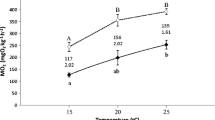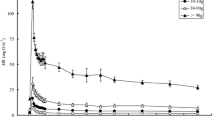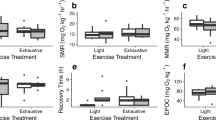Abstract
Effects of feeding on pre-exercise VO2 and excess post-exercise oxygen consumption (EPOC) after exhaustive exercise were investigated in sedentary southern catfish, active herbivorous grass carp, omnivorous crucian carp, and sluggish omnivorous darkbarbel catfish to test whether feeding had different effects on EPOC and to compare EPOC in fishes with different ecological habits. For fasting fish, the pre-exercise and peak post-exercise VO2 were higher and recovery rates were faster in crucian carp and grass carp compared to those of darkbarbel catfish and southern catfish. EPOC magnitudes of grass carp and southern catfish were significantly larger than those of crucian carp and darkbarbel catfish. Feeding had no significant effect on peak post-exercise VO2, recovery rate, and EPOC magnitude in grass carp. Both the pre-exercise and peak post-exercise VO2 increased with meal size, while the EPOC magnitude and duration decreased significantly in the larger meal size groups of crucian carp and southern catfish. In darkbarbel catfish, both the pre-exercise and peak post-exercise VO2 increased with meal size, but the VO2 increment elicited by exercise was larger in feeding groups compared with the fasting group. These results suggest that (1) the characteristics of the post-exercise VO2 profile, such as peak post-exercise VO2 and recovery rate, were closely related to the activity of fishes, whereas the EPOC magnitude was not and (2) the effects of feeding on EPOC were more closely related to the postprandial increase in VO2.

Similar content being viewed by others
References
Alsop DH, Wood CM (1997) The interactive effects of feeding and exercise on oxygen consumption, swimming performance and protein usage in juvenile rainbow trout (Oncorhynchus mykiss). J Exp Biol 200:2337–2346
Asaeda T, Priyadarshana T, Manatunge J (2001) Effects of satiation on feeding and swimming behavior of planktivores. Hydrobiologia 443:47–157
Bahr R (1992) Excess post-exercise oxygen consumption magnitude, mechanisms, and practical implications. Acta Physiol Scand Suppl 605:1–70
Cutts CJ, Metcalfe NB, Taylor AC (2002) Juvenile Atlantic salmon (Salmo salar) with relatively high standard metabolic rates have small metabolic scopes. Funct Ecol 16:73–78
Ding RH (1994) The fishes of Sichuan, China. Sichuan Science and Technology Press, Sichuan
Domenici P, Blake RW (1997) The kinematics and performance of fish fast-start swimming. J Exp Biol 200:1165–1178
Farrell AP, Thorarensen H, Axelsson M, Crocker CE, Gamperl AK, Cech JJ Jr (2001) Gut blood flow in fish during exercise and severe hypercapnia. Comp Biochem Physiol A 128:549–561
Fu SJ, Xie XJ, Cao ZD (2005) Effect of meal size on postprandial metabolic response in southern catfish (Silurus meridionalis). Comp Biochem Physiol A 140:445–451
Fu SJ, Cao ZD, Peng JL (2006) Effect of meal size on postprandial metabolic response in Chinese catfish (Silurus asotus). J Comp Physiol B 176:489–495
Fu SJ, Cao ZD, Peng JL (2007) Effect of feeding and fasting on excess post-exercise oxygen consumption in juvenile southern catfish (Silurus meridionalis Chen). Comp Biochem Physiol A 146:435–439
Fu SJ, Cao ZD, Xie XJ (2008) Feeding metabolism and locomotion metabolism in fishes. Chin J Zool 43:150–159
Gaesser GA, Brooks GA (1984) Metabolic bases of excess post-exercise oxygen consumption: a review. Med Sci Sports Exerc 16:29–43
Gladden LB, Stainsby WN, MacIntosh BR (1982) Norepinephrine increases canine skeletal muscle VO2 during recovery. Med Sci Sports Exerc 16:29–43
Hancock TV, Gleeson TT (2002) Metabolic recovery in the desert iguana (Dipsosaurus dorsalis) following activities of varied intensity and duration. Funct Ecol 16:40–48
Hicks JWH, Bennett AF (2004) Eat and run: prioritization of oxygen delivery during elevated metabolic states. Res Physiol Neurol 144:215–224
Kieffer JD, Wakefield AM, Litvak MK (2001) Juvenile sturgeon exhibit reduced physiological responses to exercise. J Exp Biol 204:4281–4289
Lee CG, Devlin RH, Farrell AP (2003a) Swimming performance, oxygen consumption and excess post-exercise oxygen consumption in adult transgenic and ocean-ranched coho salmon. J Fish Biol 62:753–766
Lee CG, Farrell AP, Lotto A, Hinch SG, Healey MC (2003b) Excess post-exercise oxygen consumption in adult sockeye (Oncorhynchus nerka) and coho (O. kisutch) salmon following critical speed swimming. J Exp Biol 206:3253–3260
Luo YP, Xie XJ (2008) Effects of temperature on the specific dynamic action of the southern catfish, Silurus meridionalis. Comp Biochem Physiol A 149:150–156
Milligan CL (1996) Metabolic recovery from exhaustive exercise in rainbow trout. Comp Biochem Physiol A 113:51–60
Pang X, Cao ZD, Fu SJ (2009) Effect of meal size on postprandial metabolic response in crucian carp. J Chongqing Normal Univ (Nat Sci) 26:34–36
Peng JL, Zeng LQ, Cao ZD, Fu SJ (2007) Effects of chase and air exposure on oxygen consumption and respiration frequency in Silurus meridionalis. Freshwater Fisheries 37:7–10
Plaut I (2001) Critical swimming speed: its ecological relevance. Comp Biochem Physiol A 131:41–50
Reidy SP, Kerr SR, Nelson JA (2000) Aerobic and anaerobic swimming performance of individual Atlantic cod. J Exp Biol 203:347–357
Rose RJ, Hodgson DR, Kelso TB, McCutcheon LJ, Reid TA, Bayley WM, Golnick PD (1988) Maximum O2, uptake O2, EPOC, and deficit and muscle metabolites in thoroughbred horses. J Appl Physiol 64:781–788
Scarabello M, Heigenhauser GJ, Wood CM (1992) Gas exchange, metabolite status and excess post-exercise oxygen consumption after repetitive bouts of exhaustive exercise in juvenile rainbow trout. J Exp Biol 167:155–169
Stainsby WN, Barclay JK (1970) Exercise metabolism: O2 deficit, steady level O2 uptake and O2 uptake for recovery. Med Sci Sports 2:177–181
Steffensen JF (1989) Some errors in respirometry of aquatic breathers: how to avoid and correct for them. Fish Physiol Biochem 6:49–59
Thorarensen H, Farrell AP (2006) Postprandial intestinal blood flow, metabolic rate, and exercise in Chinook salmon (Oncorhynchus tshawytscha). Physiol Biochem Zool 79:688–694
Wilkie MP, Bradshaw PG, Joanis V, Claude JF, Swindell SL (2001) Rapid metabolic recovery following vigorous exercise in burrow-dwelling larval sea lampreys (Petromyzon marinus). Physiol Biochem Zool 74:261–272
Wood CM (1991) Acid–base and ion balance, metabolism and their interactions, after exhaustive exercise in fish. J Exp Biol 160:285–308
Acknowledgments
This study was funded by the National Science Foundation of China (NSFC 30700087), the Chongqing Science and Technology Commission (CSTC 2007BB1226), and the Research Project of Chongqing Education Committee (KJ080823). We declare that the experiments comply with the current laws of the country in which the experiments were performed.
Author information
Authors and Affiliations
Corresponding author
Additional information
Communicated by G. Heldmaier.
Rights and permissions
About this article
Cite this article
Fu, SJ., Zeng, LQ., Li, XM. et al. Effect of meal size on excess post-exercise oxygen consumption in fishes with different locomotive and digestive performance. J Comp Physiol B 179, 509–517 (2009). https://doi.org/10.1007/s00360-008-0337-x
Received:
Revised:
Accepted:
Published:
Issue Date:
DOI: https://doi.org/10.1007/s00360-008-0337-x




